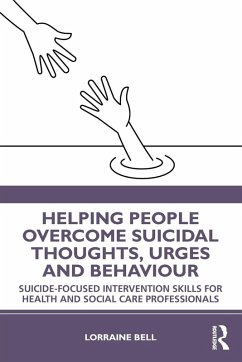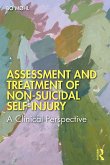Lorraine Bell
Helping People Overcome Suicidal Thoughts, Urges and Behaviour
Suicide-focused Intervention Skills for Health and Social Care Professionals
Lorraine Bell
Helping People Overcome Suicidal Thoughts, Urges and Behaviour
Suicide-focused Intervention Skills for Health and Social Care Professionals
- Broschiertes Buch
- Merkliste
- Auf die Merkliste
- Bewerten Bewerten
- Teilen
- Produkt teilen
- Produkterinnerung
- Produkterinnerung
Helping People Overcome Suicidal Thoughts, Urges and Behaviour draws together practical and effective approaches to help individuals at risk of suicide.
Andere Kunden interessierten sich auch für
![Helping the Suicidal Person Helping the Suicidal Person]() Stacey FreedenthalHelping the Suicidal Person39,99 €
Stacey FreedenthalHelping the Suicidal Person39,99 €![Self-Harm in Young People Self-Harm in Young People]() Dennis Ougrin (Institute of Psychiatry, London, UK)Self-Harm in Young People59,99 €
Dennis Ougrin (Institute of Psychiatry, London, UK)Self-Harm in Young People59,99 €![Helping Children and Young People Who Self-Harm Helping Children and Young People Who Self-Harm]() Tim McDougall (Cheshire and Merseyside Child Health Development ProHelping Children and Young People Who Self-Harm195,99 €
Tim McDougall (Cheshire and Merseyside Child Health Development ProHelping Children and Young People Who Self-Harm195,99 €![Half in Love with Death Half in Love with Death]() Joel ParisHalf in Love with Death34,99 €
Joel ParisHalf in Love with Death34,99 €![Relating to Self-Harm and Suicide Relating to Self-Harm and Suicide]() Stephen Briggs (ed.)Relating to Self-Harm and Suicide49,99 €
Stephen Briggs (ed.)Relating to Self-Harm and Suicide49,99 €![Assessment and Treatment of Non-Suicidal Self-Injury Assessment and Treatment of Non-Suicidal Self-Injury]() Bo MÃ hlAssessment and Treatment of Non-Suicidal Self-Injury37,99 €
Bo MÃ hlAssessment and Treatment of Non-Suicidal Self-Injury37,99 €![Letting Go of Self-Destructive Behaviors Letting Go of Self-Destructive Behaviors]() Lisa FerentzLetting Go of Self-Destructive Behaviors49,99 €
Lisa FerentzLetting Go of Self-Destructive Behaviors49,99 €-
-
-
Helping People Overcome Suicidal Thoughts, Urges and Behaviour draws together practical and effective approaches to help individuals at risk of suicide.
Produktdetails
- Produktdetails
- Verlag: Taylor & Francis Ltd
- Seitenzahl: 216
- Erscheinungstermin: 31. März 2021
- Englisch
- Abmessung: 234mm x 156mm x 12mm
- Gewicht: 340g
- ISBN-13: 9780367566456
- ISBN-10: 0367566451
- Artikelnr.: 60594494
- Herstellerkennzeichnung
- Libri GmbH
- Europaallee 1
- 36244 Bad Hersfeld
- gpsr@libri.de
- Verlag: Taylor & Francis Ltd
- Seitenzahl: 216
- Erscheinungstermin: 31. März 2021
- Englisch
- Abmessung: 234mm x 156mm x 12mm
- Gewicht: 340g
- ISBN-13: 9780367566456
- ISBN-10: 0367566451
- Artikelnr.: 60594494
- Herstellerkennzeichnung
- Libri GmbH
- Europaallee 1
- 36244 Bad Hersfeld
- gpsr@libri.de
Lorraine Bell is a Consultant Clinical Psychologist with Solent NHS Trust, fellow of the British Psychological Society and leads the Psychological Therapies Service in secondary mental health for Portsmouth. She is also the Suicide Prevention and Dialectical Behavior Therapy lead for the Trust.
Part 1 Understanding suicide and risk
1.1 Suicide statistics and UK Policy
1.2 Definitions
1.3 Stigma and common myths about suicide
1.4 From thought to contemplation to preparation to action
1.5 Help seeking and barriers to help seeking
1.6 Suicide and mental health
1.8 Risk and protective factors
1.9 Models of suicide
1.10 Intervening to help people at risk of suicide - who, where and when
Part 2 Safety and treatment planning principles
2.1 Suicide-focussed interventions and protocols from research
2.2 Providing a suicide focused intervention alongside other levels of intervention for people with different levels of risk
2.3 Coming alongside: Cultivating a trusting relationship and engaging the client
2.4 Assessing risk
2.5 How many sessions?
2.6 Agreeing a treatment plan or SFI
2.7 Working with families and partners
2.8 Identifying direct and indirect drivers
2.9 Planning and pacing the SFI
2.10 Building skills and coping strategies and shaping effective help-seeking
2.11 Ending the intervention
2.12 Training, support and supervision for staff
Part 3 Key suicide intervention skills
3.1 Validation
3.2 Chain or functional analysis of suicidal behaviour
3.3 Safety planning: Promoting adherence to the plan
3.4 Reducing access to means and 'shaping' skilful behaviour including appropriate help-seeking
3.5 Exploring ambivalence, reasons for living and reasons for dying
3.6 Problem solving
3.7 Building positive experiences and a life worth living: Working with needs, values and goals
3.8 How to make and use a hope box
3.9 Building mindfulness and mindfulness-based skills
3.10 Telephone coaching
1.1 Suicide statistics and UK Policy
1.2 Definitions
1.3 Stigma and common myths about suicide
1.4 From thought to contemplation to preparation to action
1.5 Help seeking and barriers to help seeking
1.6 Suicide and mental health
1.8 Risk and protective factors
1.9 Models of suicide
1.10 Intervening to help people at risk of suicide - who, where and when
Part 2 Safety and treatment planning principles
2.1 Suicide-focussed interventions and protocols from research
2.2 Providing a suicide focused intervention alongside other levels of intervention for people with different levels of risk
2.3 Coming alongside: Cultivating a trusting relationship and engaging the client
2.4 Assessing risk
2.5 How many sessions?
2.6 Agreeing a treatment plan or SFI
2.7 Working with families and partners
2.8 Identifying direct and indirect drivers
2.9 Planning and pacing the SFI
2.10 Building skills and coping strategies and shaping effective help-seeking
2.11 Ending the intervention
2.12 Training, support and supervision for staff
Part 3 Key suicide intervention skills
3.1 Validation
3.2 Chain or functional analysis of suicidal behaviour
3.3 Safety planning: Promoting adherence to the plan
3.4 Reducing access to means and 'shaping' skilful behaviour including appropriate help-seeking
3.5 Exploring ambivalence, reasons for living and reasons for dying
3.6 Problem solving
3.7 Building positive experiences and a life worth living: Working with needs, values and goals
3.8 How to make and use a hope box
3.9 Building mindfulness and mindfulness-based skills
3.10 Telephone coaching
Part 1 Understanding suicide and risk
1.1 Suicide statistics and UK Policy
1.2 Definitions
1.3 Stigma and common myths about suicide
1.4 From thought to contemplation to preparation to action
1.5 Help seeking and barriers to help seeking
1.6 Suicide and mental health
1.8 Risk and protective factors
1.9 Models of suicide
1.10 Intervening to help people at risk of suicide - who, where and when
Part 2 Safety and treatment planning principles
2.1 Suicide-focussed interventions and protocols from research
2.2 Providing a suicide focused intervention alongside other levels of intervention for people with different levels of risk
2.3 Coming alongside: Cultivating a trusting relationship and engaging the client
2.4 Assessing risk
2.5 How many sessions?
2.6 Agreeing a treatment plan or SFI
2.7 Working with families and partners
2.8 Identifying direct and indirect drivers
2.9 Planning and pacing the SFI
2.10 Building skills and coping strategies and shaping effective help-seeking
2.11 Ending the intervention
2.12 Training, support and supervision for staff
Part 3 Key suicide intervention skills
3.1 Validation
3.2 Chain or functional analysis of suicidal behaviour
3.3 Safety planning: Promoting adherence to the plan
3.4 Reducing access to means and 'shaping' skilful behaviour including appropriate help-seeking
3.5 Exploring ambivalence, reasons for living and reasons for dying
3.6 Problem solving
3.7 Building positive experiences and a life worth living: Working with needs, values and goals
3.8 How to make and use a hope box
3.9 Building mindfulness and mindfulness-based skills
3.10 Telephone coaching
1.1 Suicide statistics and UK Policy
1.2 Definitions
1.3 Stigma and common myths about suicide
1.4 From thought to contemplation to preparation to action
1.5 Help seeking and barriers to help seeking
1.6 Suicide and mental health
1.8 Risk and protective factors
1.9 Models of suicide
1.10 Intervening to help people at risk of suicide - who, where and when
Part 2 Safety and treatment planning principles
2.1 Suicide-focussed interventions and protocols from research
2.2 Providing a suicide focused intervention alongside other levels of intervention for people with different levels of risk
2.3 Coming alongside: Cultivating a trusting relationship and engaging the client
2.4 Assessing risk
2.5 How many sessions?
2.6 Agreeing a treatment plan or SFI
2.7 Working with families and partners
2.8 Identifying direct and indirect drivers
2.9 Planning and pacing the SFI
2.10 Building skills and coping strategies and shaping effective help-seeking
2.11 Ending the intervention
2.12 Training, support and supervision for staff
Part 3 Key suicide intervention skills
3.1 Validation
3.2 Chain or functional analysis of suicidal behaviour
3.3 Safety planning: Promoting adherence to the plan
3.4 Reducing access to means and 'shaping' skilful behaviour including appropriate help-seeking
3.5 Exploring ambivalence, reasons for living and reasons for dying
3.6 Problem solving
3.7 Building positive experiences and a life worth living: Working with needs, values and goals
3.8 How to make and use a hope box
3.9 Building mindfulness and mindfulness-based skills
3.10 Telephone coaching









